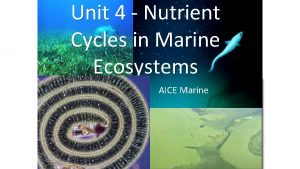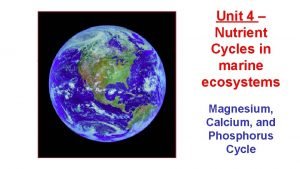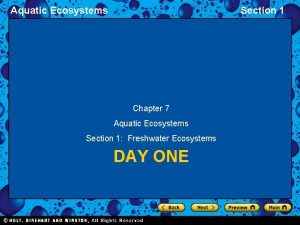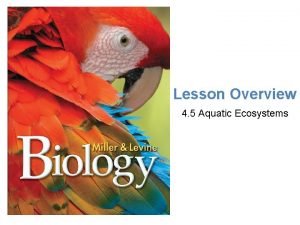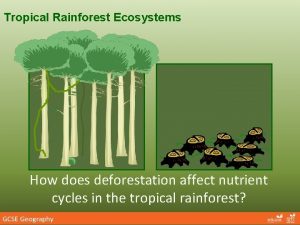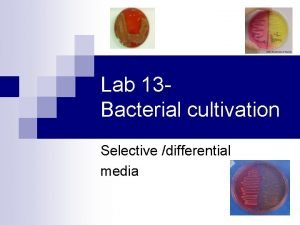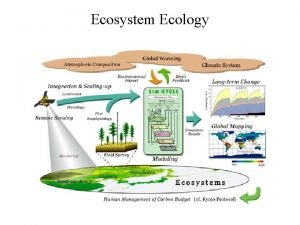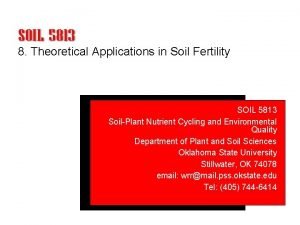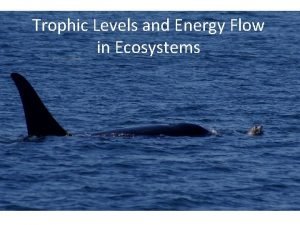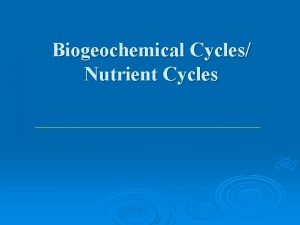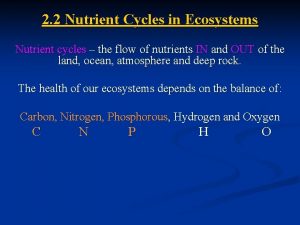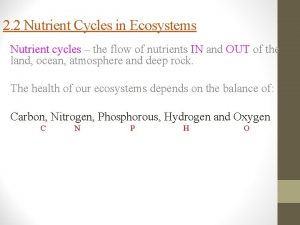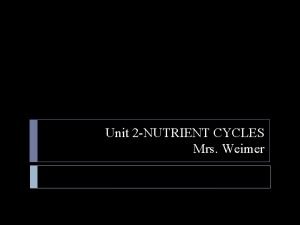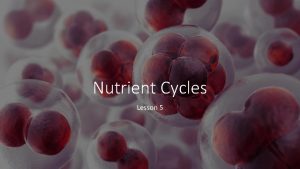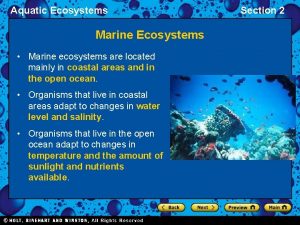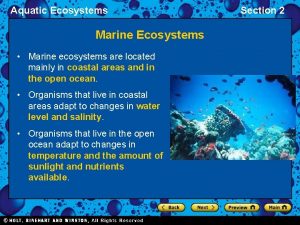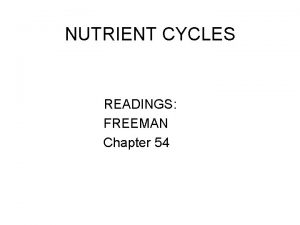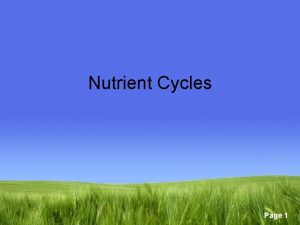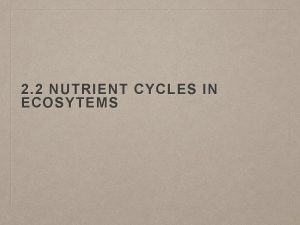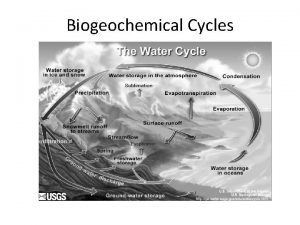Unit 4 Nutrient Cycles in marine ecosystems Nitrogen

















- Slides: 17

Unit 4 – Nutrient Cycles in marine ecosystems Nitrogen and Carbon Cycle

The Nitrogen Cycle • 78% of troposphere is N 2, 0% utilized in respiration • Present in proteins, moves through food chain • Most complex cycle • Disrupted by – – Burning fuel (releases nitric oxides) Increased use of fertilizer Removal from topsoil Addition to aquatic ecosystems

Conversion of Atmospheric Nitrogen to usage nitrogen N 2 Soil Acid soil bacteria NH 3 NH 4

Nitrogen Cycle • N 2 gas is modified by nitrogen fixing bacteria into ammonia (NH 3) (nitrogen fixation) • Bacteria turn nitrogenous waste and detritus into ammonia (ammonification) • NH 3 is converted into nitrite (N 02) which is used to produce nitrate (N 03) (nitrification) • Other bacteria convert nitrite into gas which enters the air (denitrification)

5 steps 1. Nitrogen fixation: N 2 converted to NH 3 Ammonia…combustion, volcanism, lightening and industrial processes. Nitrogenase: nitrogen fixing cyanobacteria employ this enzyme in aquatic environments. Bacteria live beneath oxygen proof slime on the roots of certain plants and inside special nodules on the roots of lugumes(beans)…Rhizobium

2. Nitrification: the conversion of NH 3 ammonia or ammonium NH 4+ to Nitrate NO 3 -. Performed by soil nitrifying bacteria. 3. Assimilation: Plant roots absorb nitrate, or ammonium and assimilate the nitrogen of these molecules to into plant proteins and nuclei acids. *** When animals consume plants they assimilate amino acids and make proteins.

4. Ammonification: Conversion of biological nitrogen compounds into ammonia. • Nitrogen waste such as urea and uric acid. • Nitrogen waste decomposes and is released into the abiotic environment. • Ammonifying bacteria carry on this process. 5. Denitrification: reduction of nitrate to gaseous N 2. Live were there is no free oxygen. Found deep in the soil near the water table.

Human Impact on the Nitrogen Cycle • Nitrogen cycle is being altered by nitrogen fertilizer produced from nitrogen gas for agriculture… 141 million tons LAND…RIVERS…OCEANS…DEAD ZONES!!! • Leach into groundwater. • Nitrous oxides from cars make photochemical smog. • Form nitric acid deposition acidifying lakes and streams.

Cycling of Materials within Ecosystems Nitrogen cycle: Biological nitrogen fixation Atmospheric nitrogen (N 2) Nitrogen fixation by humans Decomposition Denitrification NH 3 & NH 4 - Internal cycling Plant & animal proteins Assimilation Nitrification NO 3 -


The Carbon Cycle • Key role in Earth’s thermostat – Absorbed by ocean, utilized by plants in photosynthesis, humans in digestion – Sinks (storage) in lithosphere (largest reservoir – limestone and other sedimentary rock), hydrosphere (ocean), atmosphere (CO 2) and in the biosphere (dead animals, wood, plants…) – Released by fires, decomposition, volcanoes, and human respiration

Carbon Dioxide Cycle 1. . 037% Atmosphere 2. Present in the ocean as carbonate, bicarbonate and other forms 3. Present in rocks PHOTOSYNTHESIS “fixes” CO 2 into complex sugar compounds. Photosynthesis= biotic + abiotic = sugar!!!

Sea Floor Covered with the remains of phytoplankton kilometers thick… The ocean is the greatest carbon dioxide sink on the planet. Limestone that becomes land via uplift will deteriorate and return carbon to the carbon cycle.

Fossil Fuels. 1. By-product of the carbon cycle. 2. Vast deposits of carbon compounds 3. Remains of ancient organisms Can be returned to the atmosphere by burning…COMBUSTION… Rapid oxidation of organic molecules

Global Warming 1. Before the industrial revolution in 1850 carbon dioxide was in a steady state. 2. Less than half of the carbon that is release remains in the atmosphere…vegetation on land the ocean 3. ½ of the CO 2 is unaccounted for!!! 4. The rise of CO 2 in the atmosphere caused by humaninduced changes


Cycling of Materials within Ecosystems Carbon cycle:
 Nutrient cycles in marine ecosystems
Nutrient cycles in marine ecosystems Salmonella transport media
Salmonella transport media Biogeochemical cycles apes
Biogeochemical cycles apes Gersmehl diagram
Gersmehl diagram Compare and contrast carbon and nitrogen cycles
Compare and contrast carbon and nitrogen cycles Biological use of magnesium in marine ecosystems
Biological use of magnesium in marine ecosystems What two locations are marine ecosystems usually located?
What two locations are marine ecosystems usually located? Photic and aphotic zones
Photic and aphotic zones Upper limb
Upper limb How does deforestation affect the nutrient cycle
How does deforestation affect the nutrient cycle Six nutrient groups
Six nutrient groups Non fastidious definition microbiology
Non fastidious definition microbiology Interfering agent eggs
Interfering agent eggs Nutrient cycle in the serengeti
Nutrient cycle in the serengeti Deciduous woodlands
Deciduous woodlands Foods used in nutrition activities should be nutrient-dense
Foods used in nutrition activities should be nutrient-dense Brays nutrient mobility concept
Brays nutrient mobility concept Energy in trophic levels
Energy in trophic levels
